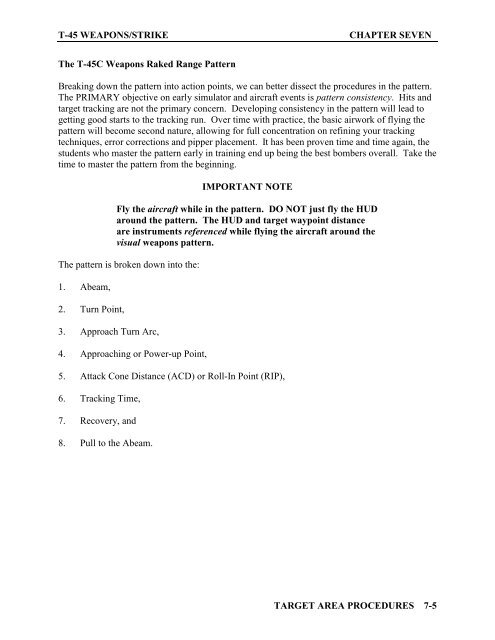FLIGHT TRAINING INSTRUCTION T-45 WEAPONS/STRIKE - Cnatra
FLIGHT TRAINING INSTRUCTION T-45 WEAPONS/STRIKE - Cnatra
FLIGHT TRAINING INSTRUCTION T-45 WEAPONS/STRIKE - Cnatra
You also want an ePaper? Increase the reach of your titles
YUMPU automatically turns print PDFs into web optimized ePapers that Google loves.
T-<strong>45</strong> <strong>WEAPONS</strong>/<strong>STRIKE</strong> CHAPTER SEVEN<br />
The T-<strong>45</strong>C Weapons Raked Range Pattern<br />
Breaking down the pattern into action points, we can better dissect the procedures in the pattern.<br />
The PRIMARY objective on early simulator and aircraft events is pattern consistency. Hits and<br />
target tracking are not the primary concern. Developing consistency in the pattern will lead to<br />
getting good starts to the tracking run. Over time with practice, the basic airwork of flying the<br />
pattern will become second nature, allowing for full concentration on refining your tracking<br />
techniques, error corrections and pipper placement. It has been proven time and time again, the<br />
students who master the pattern early in training end up being the best bombers overall. Take the<br />
time to master the pattern from the beginning.<br />
IMPORTANT NOTE<br />
Fly the aircraft while in the pattern. DO NOT just fly the HUD<br />
around the pattern. The HUD and target waypoint distance<br />
are instruments referenced while flying the aircraft around the<br />
visual weapons pattern.<br />
The pattern is broken down into the:<br />
1. Abeam,<br />
2. Turn Point,<br />
3. Approach Turn Arc,<br />
4. Approaching or Power-up Point,<br />
5. Attack Cone Distance (ACD) or Roll-In Point (RIP),<br />
6. Tracking Time,<br />
7. Recovery, and<br />
8. Pull to the Abeam.<br />
TARGET AREA PROCEDURES 7-5
















